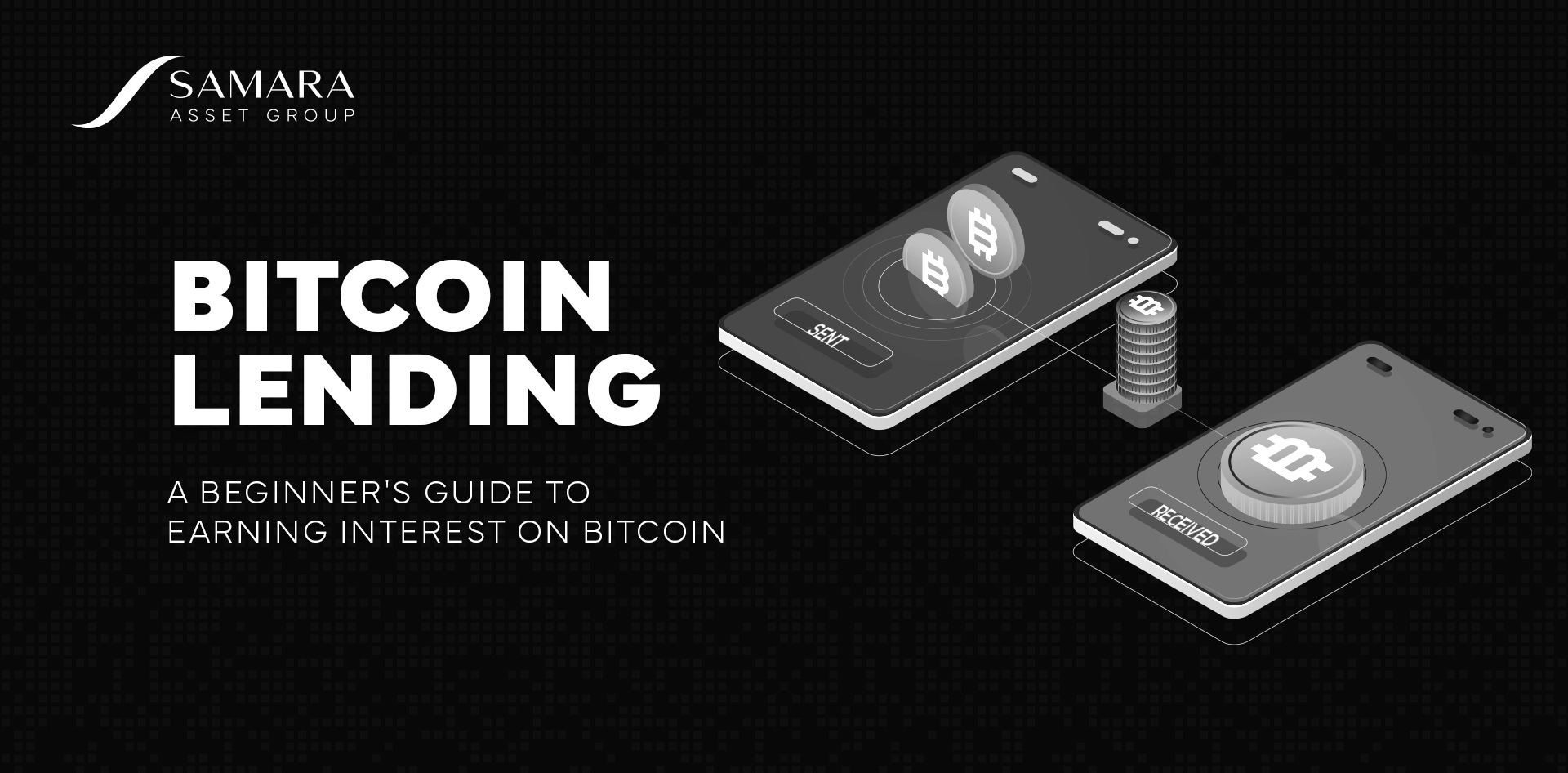Bitcoin
Bitcoin CPI
Venture Portfolio
Funds
Market Insights
Indicators
About
Contact

January 30, 2024





Bitcoin lending enables digital asset investors to earn interest on their Bitcoin holdings by lending their assets to borrowers in the digital asset lending markets.
In this guide, you will learn what Bitcoin lending is, how it works, and why investors consider this investment option.
Bitcoin lending involves one party lending their BTC holdings for a set period to another party in exchange for regular interest payments, allowing investors to generate income from their idle Bitcoin.
Like traditional lending, lenders receive back the principal amount plus interest from the borrower. Interest rates in crypto lending are often higher than in conventional lending. Compared to an APY of 0.46% earned by conventional savings accounts in the US, the APYs in crypto borrowing can be as high as 15% or more.
Bitcoin loans also require collateral to reduce the lender’s risk. This collateral is liquidated and given to the lender should the borrower fail to repay the entire loan plus interest at the end of the borrowing period.
Depending on the lending platform, borrowers may be required to over-collateralize or under-collateralize their loans.
Bitcoin lending involves three parties: the lender, the borrower, and the platform.
The lender’s goal is to earn interest on their idle crypto assets, while the borrower aims to access liquidity by putting up a crypto asset as collateral. The platform brings both parties together, allowing them to lend their crypto assets or borrow against their crypto holdings.
Lenders deposit their Bitcoin on a lending platform where it is lent to borrowers who are unknown to them. They then receive interest rate payments and the principal amount from the platform, whose role also includes liquidating the collateral should the borrower default on the crypto loan.
Lenders can minimize their risk by lending on platforms that allow overcollateralized loans. These types of loans expect the borrower to put up a higher collateral in value than the loan provided. The extra collateral is a buffer, protecting the lender from price volatility.
Bitcoin loans can also be undercollateralized. Contrary to over-collateralization, these types of loans expose lenders to higher levels of risk because the value of the collateral is less than the loan amount.
Another loan arrangement is a flash loan, which does not require collateral. However, the borrower is expected to repay the loan plus interest within the same block. If they can’t do this before the block is validated, the transaction is canceled, and they can’t borrow any funds.

Bitcoin lending can take place on centralized or decentralized platforms. Here is how they both compare.
Centralized Bitcoin lending is controlled by a centralized platform that acts as an intermediary. This platform could be a centralized exchange like Binance and Coinbase or a digital asset lender such as CoinLoan or Ledn.
Users of centralized lending platforms must first create accounts and complete KYC verification before lending or borrowing.
This lending process entails depositing BTC in a custodial wallet on the lending platform and waiting for regular interest payments. Centralized platforms typically pool funds from different lenders and use them to offer loans.
Lenders can lock their funds in a fixed or flexible interest-earning account. The fixed account restricts them from withdrawing the principal plus interest until a specified period has elapsed. On the contrary, lenders can withdraw the principal and interest at any time with a flexible account.
Although centralized platforms act as intermediaries and custodians during lending, all deposits and withdrawals occur on-chain.
There are no intermediaries or custodians in decentralized Bitcoin lending. Instead, the lending process is handled by a smart contract running on a decentralized protocol. Moreover, users can interact with a lending protocol directly from their non-custodial wallets without signing up for an account or going through the KYC process.
Decentralized lending requires lenders to deposit their BTC holdings into a smart-contract-powered lending pool. This money is then lent to borrowers, who must lock their collateral in a smart contract. Collateral can only be accessed once the borrower has repaid the loan plus interest. The smart contract is also in charge of distributing interest payments to all the lenders in a pool.
Decentralized lending protocols calculate interest rates algorithmically based on the supply and demand of the assets in a pool.
Compound, Aave, Curve, and MakerDAO are examples of decentralized crypto lending protocols. These platforms are built on Ethereum and other chains. However, Bitcoin-focused lending protocols built on Bitcoin layers like Stacks and RSK have started to emerge.

Investors are lending their Bitcoin to earn investment income through interest rate payments. Lending enables investors to utilize their BTC holdings rather than leaving them idle in a wallet. As a result, investors can potentially grow their digital asset portfolios over time without too much active management.
A bear market is another motivator for people to turn to Bitcoin lending. Investors earn interest via Bitcoin lending to mitigate some of the losses incurred during price declines.
While Bitcoin lending does generate additional income, it exposes investors to several risks that could lead to losses. Potential lenders should, therefore, consider the following risks before lending their Bitcoin.
DeFi lending protocols that have not thoroughly audited their smart contracts can expose users’ funds to theft if hackers exploit the bugs in these contracts.
Some lending platforms lock lenders’ assets for a certain period, during which withdrawals are restricted. This can limit a lender’s liquidity, especially if they need quick funds.
Lending on a centralized platform puts investors at risk of losing access to their assets if the company goes bankrupt or shuts down for other reasons. Since centralized platforms control the private keys to users’ funds, lenders cannot access their BTC if the company closes down. They are, therefore, forced to wait for a legal process to establish a reimbursement schedule.
Like any other investment in the digital asset markets, Bitcoin lending has its pros and cons. Investors must, therefore, weigh the risks against the benefits before choosing to lend their coins.
Furthermore, it is worth noting that crypto lending platforms operate differently. Therefore, investors should do their due diligence to understand how a platform’s lending process works. Conducting this research can help investors choose well-managed, secure, and transparent platforms.
Bitcoin doesn’t pay interest natively. However, Bitcoin does pay interest if you lend it on a centralized or decentralized platform. Lending enables investors to earn interest on their crypto assets instead of letting them sit idle in a wallet.
The rate of yields earned through Bitcoin lending will vary from platform to platform. As a result, lenders should consider the APY when selecting a lending platform.
You can earn interest on Bitcoin by lending it to borrowers looking for liquidity. Bitcoin lending takes place on centralized exchanges like Binance or lending-focused platforms like CoinLoan. DeFi protocols such as Aave and Compound also offer lending products powered by smart contracts. Interest earnings on Bitcoin lending differ from platform to platform.